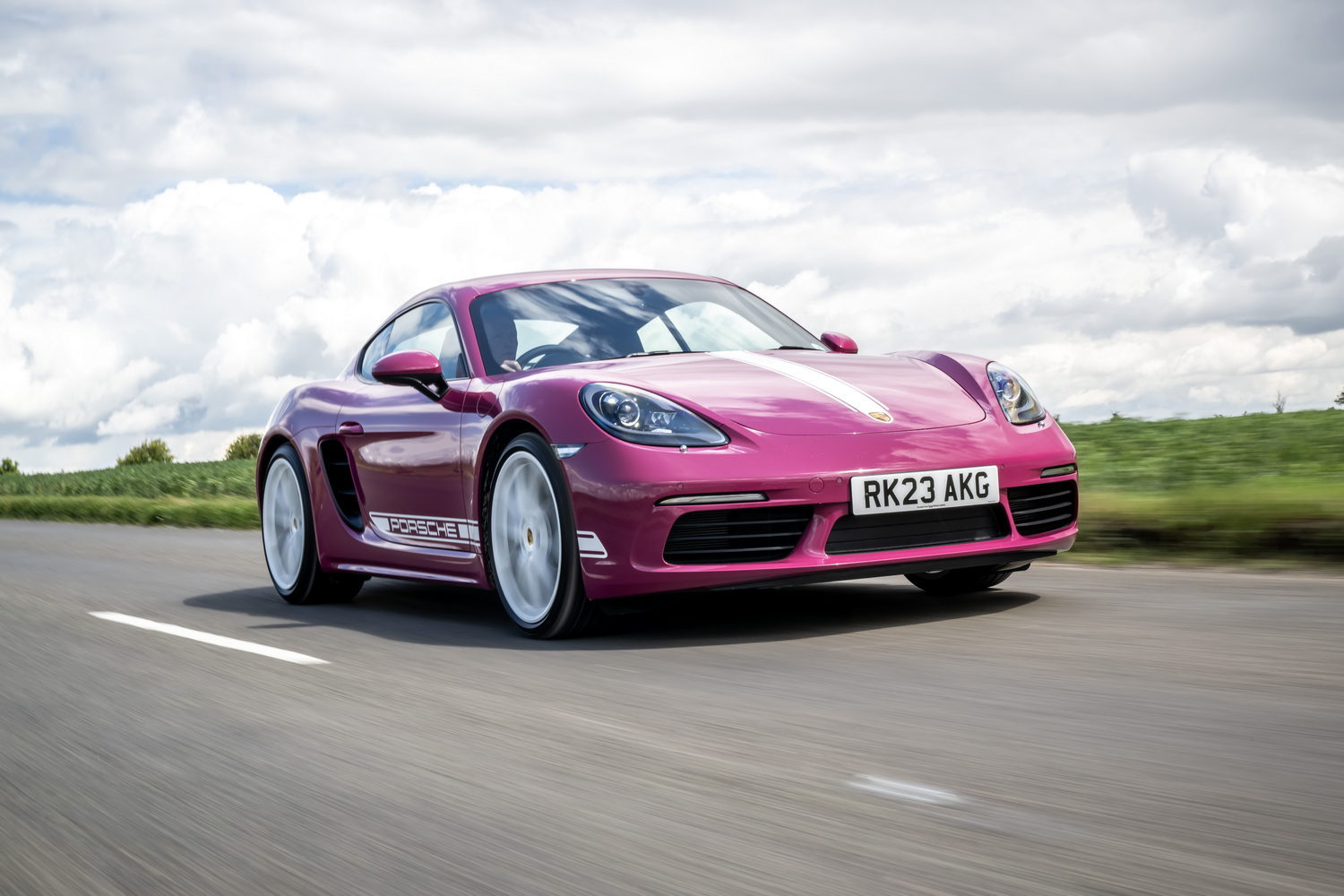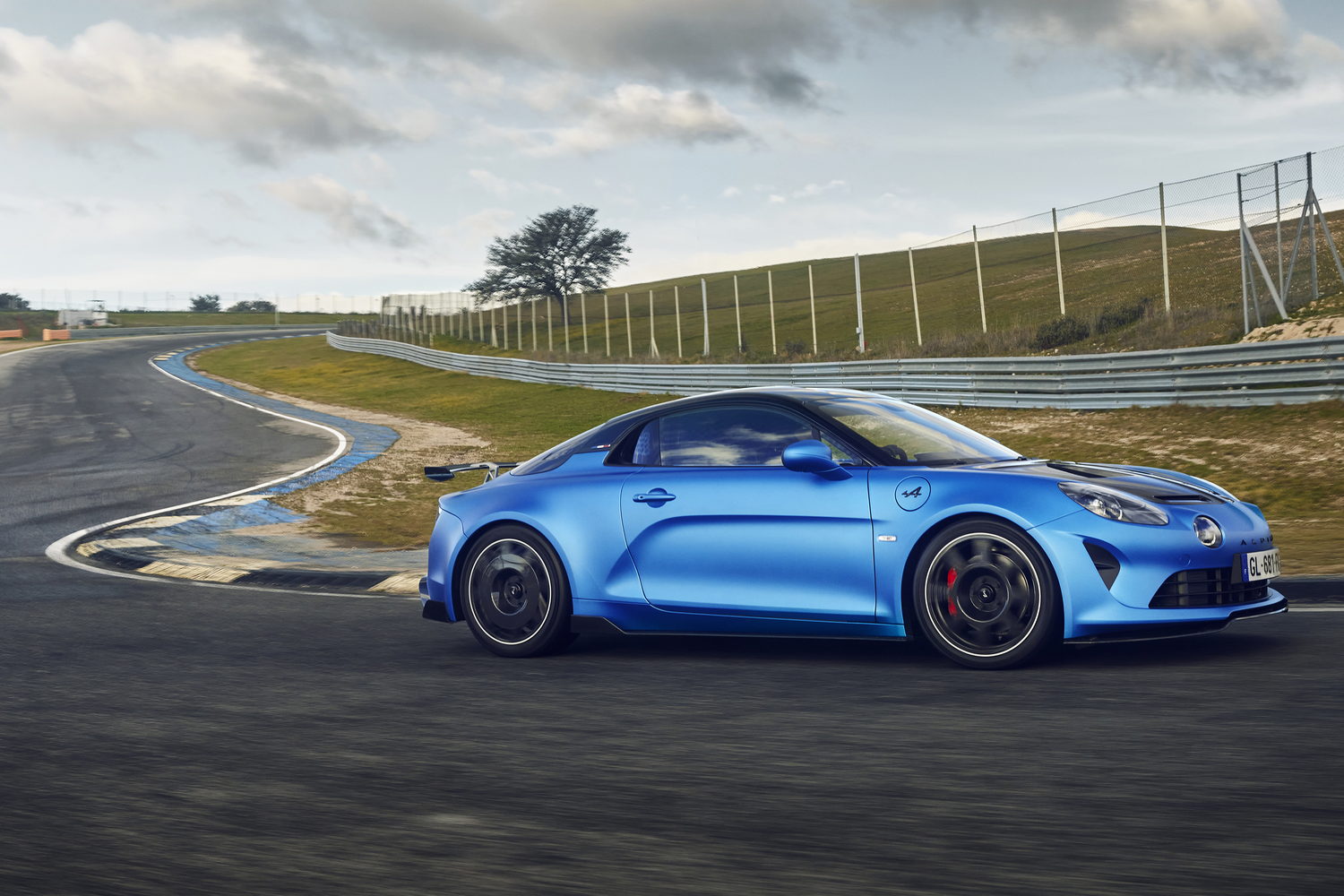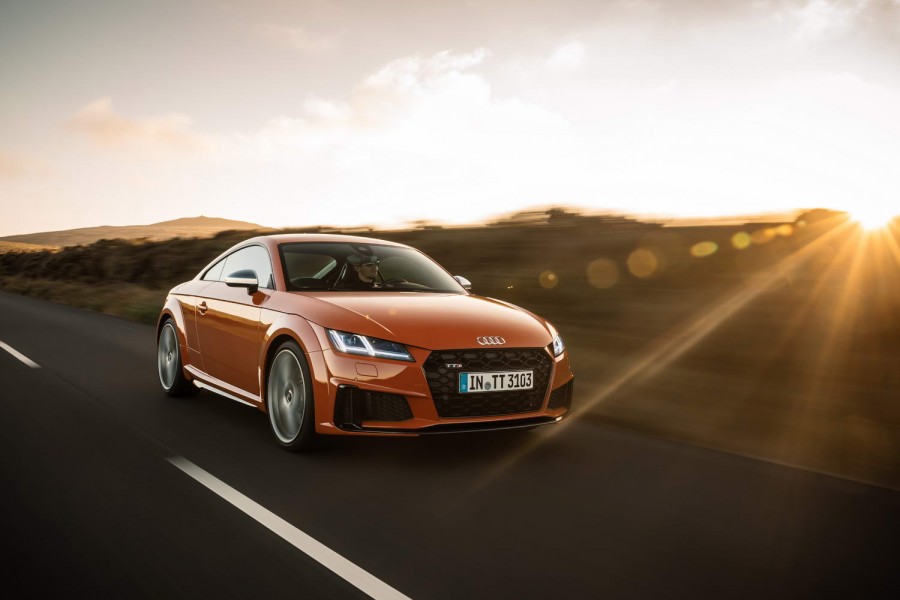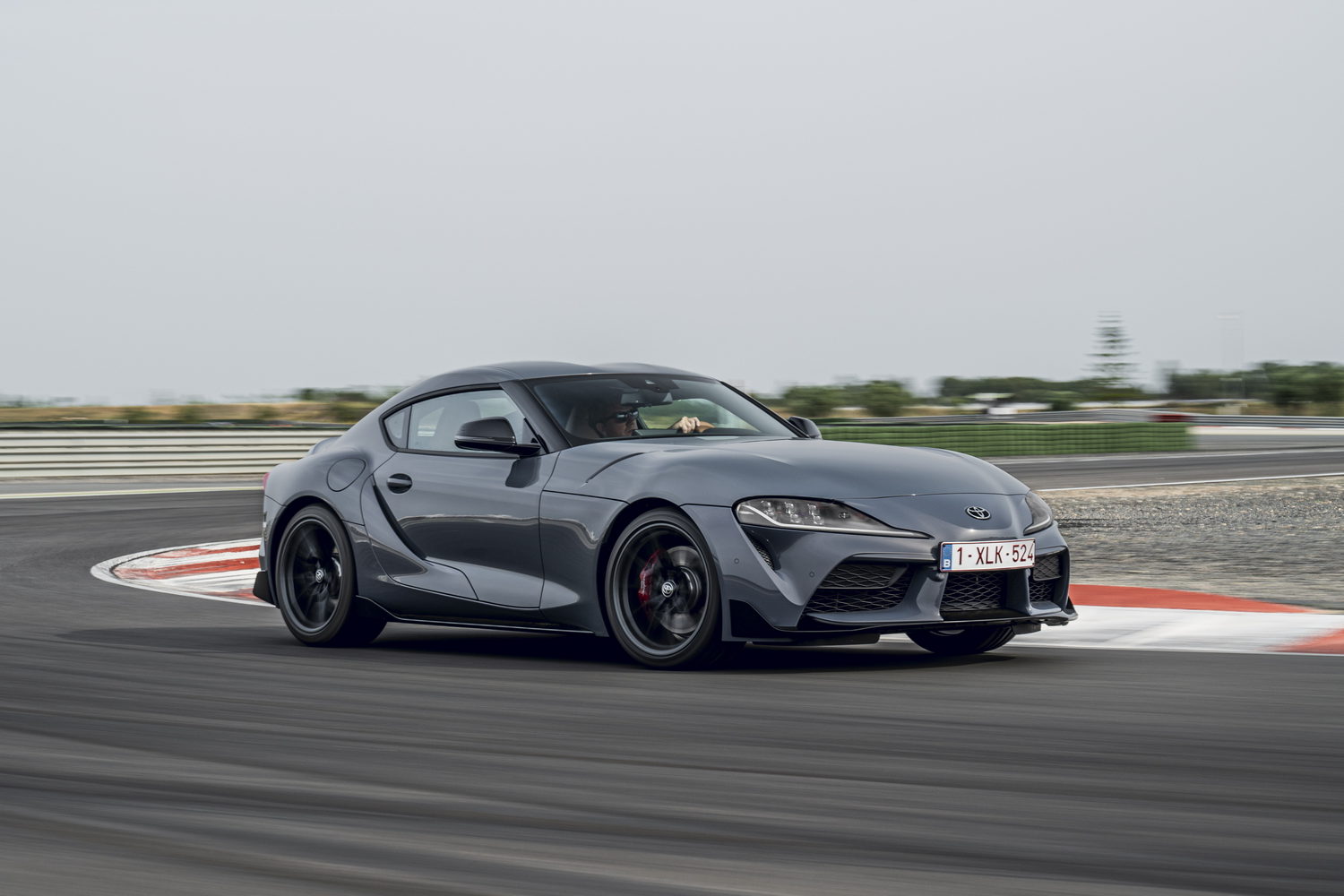Porsche loves finding niches within niches. Think all 911s are the same? Think again; the GT3 and the Turbo are at very opposite ends of the 911 spectrum, and the same goes for the Carrera and the Dakar. And everything in between, for that matter. The German company is trying to add some of the same magic to the 718 Cayman range, despite the fact the car has entered its twilight years. So will the Style Edition, with its eye-catching design tweaks, really add another string to the Cayman's bow, or is it just an expensive vanity project?
In the metal
We can't really talk about the Style Edition without first talking about its colour scheme. It's called Ruby Star Neo, and it's a kind of cross between pink and purple (we can't really decide which it is) that pays homage to old 911s. It contrasts nicely with the white wheels and stripes. It begs questions about the wisdom of such a colour scheme and while some will love it others will be pleased to know you don't have to specify it. Us? We like it, particularly when every car on the road seems to be some dull shade of grey, but we're not sure we could live with it.
Whether you opt for Ruby Star Neo or not, the colour is not the be-all and end-all for the Style Edition. Every car comes with 20-inch 718 Spyder wheels with coloured Porsche crests, plus black tailpipes and Porsche lettering in high-gloss silver. There's a decorative stripe on the luggage compartment lid at the front and Porsche lettering down the side, too, while customers can choose whether those accents (and the wheels) come in black or white.
In the case of our Ruby Star Neo car, the white wheels, white lettering and white stripe set it off nicely, but the wheels were filthy within minutes and that spoils the look slightly - particularly on a long road trip. Still, the black wouldn't have looked so good alongside the paintwork, so we suspect customer accent choices will entirely depend on which paint colour they pick.
Inside, though, the car gets much the same treatment no matter what. There's a black leather package with contrast stitching in 'Chalk', while the door sill panels are made from stainless steel and are illuminated. There are Porsche crests on the head restraints, too, plus some other options, including auto-dimming mirrors, automatic wipers and a heated steering wheel, not to mention the floor mats with Chalk contrast stitching.
But almost all these upgrades are aesthetic, really, and they neither add nor subtract much from the entry level 718 Cayman. Or at least not one with a few optional extras applied. That's no bad thing, because the cabin is well made and generally well thought out, but it is beginning to show its age. The world has moved on since the 718 Cayman was launched seven years ago, and the cabin is looking a bit old-school in places.
That's no slight on the quality or the design, but even Porsche admits the digital displays look a bit old compared with the systems in the modern 911 or the Taycan. There's nothing wrong with them per se, and the touchscreen works nicely with the Apple CarPlay smartphone integration tech, but it's all a bit last-generation compared with the most modern sports cars.
At least it's relatively spacious by the standards of two-seat coupes, with more than enough headroom for even quite tall drivers and passengers. There's plenty of seat adjustment, too, so it's easy enough to get comfortable. Naturally, luggage and passenger space are a bit of a pain with no rear seats, but the same is true of other cars in this class and the Porsche makes up for that to a point by dint of having two luggage areas. With the engine hogging the middle of the car, neither luggage bay is what you'd call massive, but the 272-litre boot is useful enough, as is the 184-litre front luggage compartment under what would normally be the bonnet.
Driving it
Under the skin, the Style Edition is essentially the same as the standard 718 Cayman, which comes with a 2.0-litre turbocharged petrol engine. It's a flat-four, or horizontally opposed four-cylinder, to give it its proper name, and it has quite a distinctive voice. Perhaps more importantly, it's mounted in the middle of the car, just behind the seats, and it packs 300hp and 380Nm of torque.
All that heads to the rear wheels via either a six-speed manual gearbox or the seven-speed twin-clutch automatic that Porsche calls PDK. It's a German thing. With the standard manual gearbox on board, the Style Edition gets from 0-100km/h in 5.1 seconds, but that falls to 4.7 seconds with the automatic gearbox and the Sport Chrono Package. Either way, the top speed is an academic 275km/h.
In the world of Porsches, that isn't especially fast, but by everyone else's standards that's good going. And while the 2.0-litre engine is hardly the one we dream of, it's certainly going to be more than enough for the vast majority of owners. Specify the optional sports exhaust and it feels particularly rorty, but performance will be more than sufficient whether you opt for that or not.
The other advantage of the 2.0-litre engine is fuel economy. We covered more than 1,500km in our test car, driving on a mixture of country roads, urban streets and motorways, and our average fuel consumption was around seven litres every 100km, or about 40mpg. That's significantly better than the official economy, and though our car was equipped with the supposedly more efficient automatic gearbox, it was impressively easy on fuel.
But for Porsche customers and, indeed, for us, the biggest advantage of the 2.0-litre engine is lightness. The 4.0-litre versions of the Cayman are fabulous in their own ways, and the GTS 4.0 is still our favourite, but the 2.0-litre engine strikes back with a lower kerb weight than its more powerful siblings. Even with the heavier automatic gearbox on board, the Style Edition weighs just 1,365kg, whereas the GTS 4.0 with the same gearbox comes in at 1,435kg. That's like carrying an extra passenger, and it means despite a 100hp difference in power outputs, the Style Edition is only around half a second slower to 100km/h than the GTS 4.0.
And that lightness doesn't just help when it comes to straight-line speed, either. All 718 Cayman models, no matter which engine they use, are brilliant to drive, but the 2.0-litre models feel that touch more agile on tight, twisting mountain roads. They're that little bit daintier in the corners, that whisker more tolerant of abuse and that fraction more responsive to your commands.
Of course, we aren't going to pretend the difference is like night and day. We aren't even going to pretend the majority of drivers will notice, but it's there if you go looking for it. And the Cayman certainly encourages you to do that.
With the engine in the middle, the car is beautifully balanced and that makes it feel really stable and poised in corners. The steering, which is absolutely sublime, also helps in that regard, with enough feedback to let you know what's happening and enough weight to make it feel dependable and direct, but never too heavy. Factor in responsive, powerful brakes and a crisp gearbox, and you've got a car that's joyous to drive almost anywhere and immensely rewarding when you get it just right. It's playful, but capable enough to keep you out of trouble.
When cars drive so fabulously, there's normally a trade-off when it comes to ride comfort, and the Style Edition does display that to an extent. Generally speaking, though, it's pretty supple and compliant - particularly by the standards of the most powerful Cayman GT4 and GT4 RS variants. Certainly, it's supple enough to make driving across the country a relatively comfortable experience, even if it isn't quite as comfortable as, say, a Porsche Panamera.
However, it should be noted that our test car came with the Porsche Active Suspension Management (PASM) system, an optional extra that lowers the suspension by 10mm and offers a choice of two damper settings. The softer of the two provides good body control and the more compliant cruising ride, while the stiffer setting trades quite a lot of comfort for a small improvement in control. The lower suspension also makes speed bumps a moderately more stressful road feature, and the sharpest bumps will likely elicit a small scraping noise from the underside of the car.
What you get for your money
The Cayman Style Edition comes in at just under €110,000 making it less than €10,000 more expensive than the standard car. For that money, you not only get the styling tweaks, but you also get extra equipment including a heated steering wheel, two-zone climate control and parking sensors at the front and rear. Automatic windscreen wipers and leather upholstery are included in the price tag, too. Whether that represents value really depends on how much you like the styling and which options you want. It's a lot to pay for some stickers if you don't really want half of the other features.
Summary
In many ways, the Style Edition doesn't make much sense. Unless you dig the stripes, and it comes with exactly the right optional extras, it isn't really worth having over the (much cheaper) standard car. But that's no slight of the Cayman in general, because even at seven years old, and even with the smallest engine on board, the littlest Porsche is still a peach. And while it won't be to everyone's taste, the pink/purple paint does at least give it plenty of character. We just aren't sure we'd be brave enough to choose it.

























